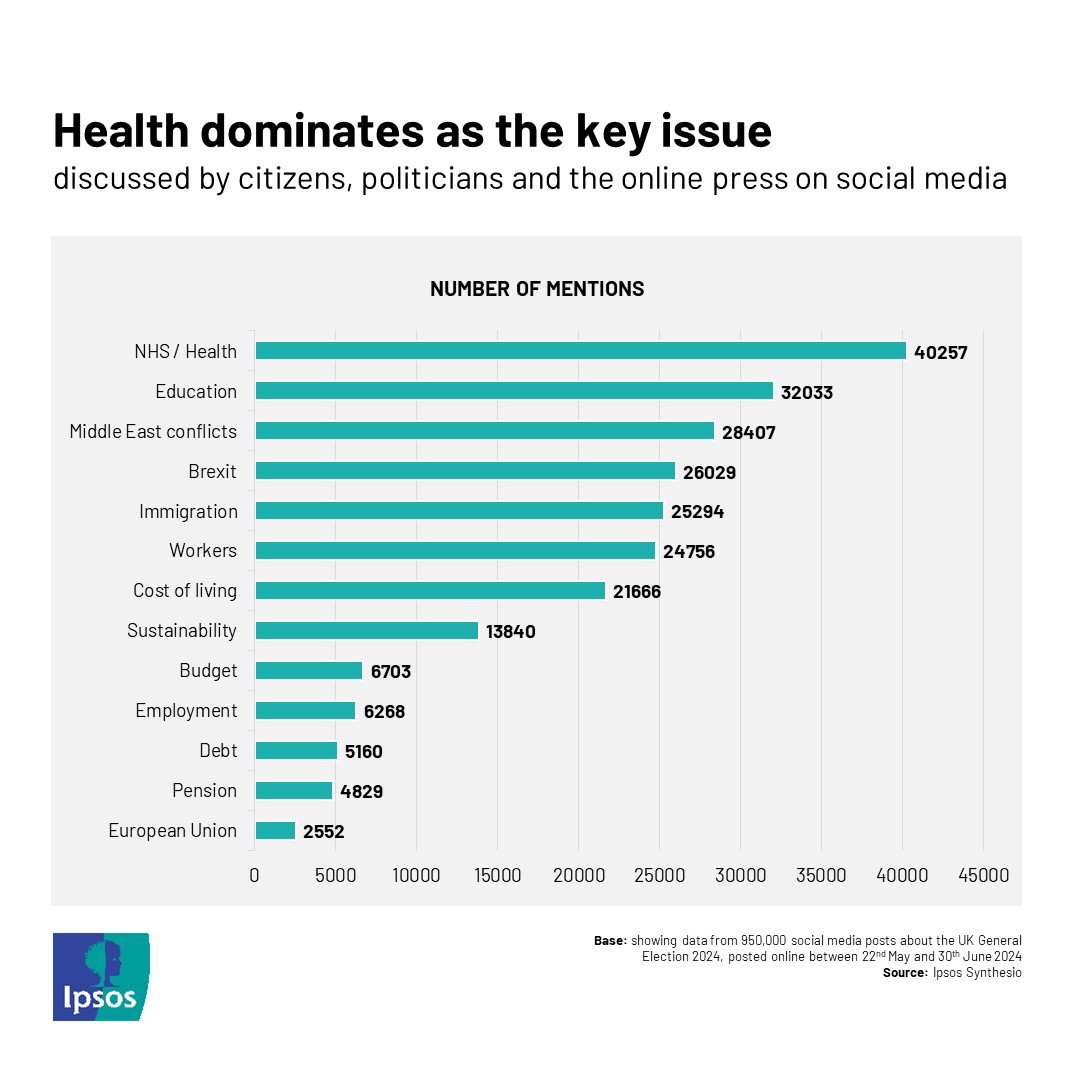From Hashtags to Votes: analysing online engagement during #GE2024
What have we learnt from the way the public have engaged with the election online?
The internet is a key battleground during the election, both as a source of news and as a tool for engaging with voters. Drawing on data from our social intelligence platform Synthesio, and our online passive measurement panel Ipsos iris, what have we learnt from the way the public have engaged with the election online?
It is important to remember that not all voters are online, and not all of those online choose to post on socials or consume online news. The data therefore reflects the behaviours and opinions of a subset of voters, nonetheless it tells a powerful story of how the campaign has evolved online.
Key findings
- Farage has generated a similar number of news page views as Sunak and Starmer since becoming leader
- There is a higher degree of activism online to vote Reform UK than other parties
- Sunak share of voice during the election has been dominated by criticism of 3 key events: £2,000, D-Day and Sky TV
- Health dominates as the key issue discussed by citizens, politicians and the online press on social media
Share of news interest online
Looking at the news pages viewed by Ipsos Iris (an online passive panel), Nigel Farage has clearly had a big impact on the news consumed by voters.
- In the closing days of June, news about Farage had more views than coverage of Sunak and Starmer.
- This is irrespective of age. Farage catches interest of all age groups: 27% of page views among 15-24 years olds, rising to 31% of page views among those aged 55-64.
Meanwhile the betting scandal appears to be one of the biggest factors in spikes in page views for Rishi Sunak.

Activism online
The Conservatives have by far the highest number of mentions on social media, cited in 49% of all posts we collected. However, this does not translate into support or a call to action.
Among the relatively small number of posts that have a direct call to vote (or not) for a party:
- Reform UK has the largest volume of posts that promote voting for their cause.
- There is as much negative activism to encourage voting #toriesout as there is positive activism to #votelabour.
- There is greater activism on social media to vote SNP or Green than there is Conservative. Though still a significant call for #neverlabour.

Key events driving commentary online
Conversation on social media peaks in line with key events and news coverage, especially surrounding the live debates.
Conversation online citing all party leaders is much more negative than positive; however, three key negative moments dominate Rishi Sunak’s campaign:
- Fallout from the £2000 tax claim
- Criticism for D-Day
- Living without Sky TV
In contrast, the biggest spike in conversation about Keir Starmer was at the launch of the Labour manifesto. Starmer has the biggest share of voice overall, mentioned in 38% of posts.
Conversation about Nigel Farage represents 12% share of voice, but this has been building – on par with mentions with Rishi Sunak as the election campaign comes to a close.

Key issues online
In line with wider polling, Health generates the most amount of election conversation online.
- Health has led consistently as a key issue online throughout the campaign, peaking during the first leaders debate when Sunak and Starmer were challenged on use of private healthcare, but also related to waiting times and investment.
- It remains a key issue for ‘citizens’ (representing 18% of their posts), the online press (18% of their posts) and for political stakeholders (17% of their posts), suggesting politicians are connecting on the issue that matters most to voters.
- Health commands similar attention in citing the Conservatives (16%) and the Labour Party (15%) but drives a much larger narrative within the Green Party – representing 30% of conversations about the Greens.

Technical note
Ipsos iris topic modelling data is based on URLs passively collected from our panel of c.10,000 UK internet users aged 15+. These URLs are from websites accessed by our panel across PCs and laptops, smartphones and tablets. The panel is recruited and weighted to be representative of the internet population demographically, geographically and by device type use.
Our elections analysis covers 2nd June –29th June and is based on a sub-sample of URLs from 413 news-category websites visited over this period . We process the text content of up to 120,000 URLs each day using a natural language processing solution, TextRazor. The 120,000 URLs are selected based on the number of page views each URL has i.e. the URLs with the most page views are prioritised. URLs can be included in multiple days, meaning that different topics can be assigned to the same URL on different days.This gives us a sub-sample of 7,266 panellists who visited news content online between 2nd June and 27th June.
TextRazor returns the list of URLs to us with up to 150 topics assigned to each URL and a confidence indicator for each topic. The higher the confidence level the more robust the topic allocation is. For this analysis, we have filtered the URLs to only include those where the topic “Elections” has been assigned with a confidence level of above 0.5. This sub-set of URLs is further filtered to only include specified topics – e.g. Rishi Sunak or Keir Stamer – which have been allocated with a confidence threshold of above 0.7
Social Media has been collected and analysed using the social media analytics platform Ipsos Synthesio, monitoring public conversation online since the 2024 UK general election announcement. The analysis presented is based on data collected from social media (e.g., X, YouTube, Instagram, TikTok, Facebook, etc), online news and press (e.g., BBC/ITV/Channel 4 news websites, dailymail.co.uk, guardian.co.uk, etc), and public forums (e.g., reddit, personal blogs, etc).
Between 22nd May and 30th June, our search query had collected over 950,000 posts: any public posts that contained key words relating to the election, main parties or party leaders.
Ipsos Synthesio which uses a combination of automated machine-led analysis, manual coding, statistical modelling, and qualitative investigation to identify the most common themes within the data and the strength of relationships between topics. The social media analysis is not representative of the general population; instead, it seeks to reflect those who have posted publicly about the 2024 general election since it was announced. Only publicly available posts are included in the analysis.
More insights about Public Sector



